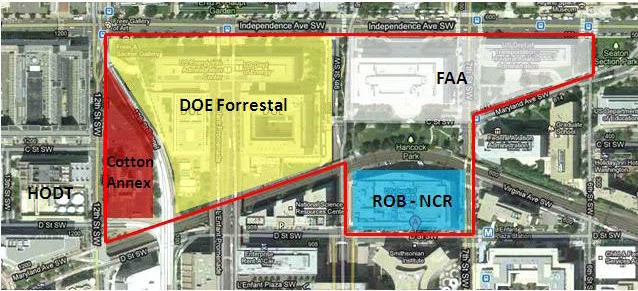
The November 19 hearing, “Federal Triangle South: Redeveloping Underutilized Federal Property Through Public Private Partnerships,” began with optimistic opening remarks. Lou Barletta (R-PA), Chairman of the House Subcommittee on Economic Development, Public Buildings and Emergency Management, launched the proceedings by recognizing significant private interest in redeveloping a cluster of aging federal buildings on 21.5 acres of land in Southwest D.C. known as the Federal Triangle South (FTS). From the vacant Cotton Annex to the outmoded Federal Aviation Administration offices, FTS facilities exemplify the need for GSA to renovate and redevelop underutilized assets in their portfolio. The current budget squeeze, said Barletta, requires innovative approaches to support redevelopment, and arrangements to exchange inefficient federal properties for more appropriate properties or services are a promising alternative.
A witness representing the National Capital Planning Commission (NCPC), Chairman L. Preston Bryant, Jr., painted vivid images of the problems and possibilities for FTS. Dominated by the Brutalist-style James V. Forrestal Building, single-use federal offices are intertwined with streets, freeway ramps and active rail lines that snarl local traffic and imperil pedestrians. In contrast, Bryant conjured a future of public and private offices, residences and hotels, retail and cultural sites, with pedestrian-friendly interconnections including easy access to mass transit. The redeveloped FTS would comprise the northern third of the planned 110-acre Southwest Ecodistrict, an initiative being developed by the NCPC, GSA and 15 other federal and local partners. Numerous public-private partnerships will be required to achieve the initiative’s sustainability goals—including reduced waste to landfills, improved stormwater management and 51% reduction in greenhouse gas emissions—within the envisioned mixed-use neighborhoods by 2030. As part of the SW Ecodistrict transformation, said Bryant, the FTS offers a chance to reduce federal expenses throughout an area, not just building-by-building.
Witness Dan Tangherlini, administrator of the GSA, focused on his agency’s responsibilities as stewards of real estate around the country. With access to the Federal Buildings Fund limited by Congress, the GSA must actively seek other ways to accommodate tenants’ needs for renovations and new construction. In December, 2012, the agency issued a Request for Information (RFI) for FTS redevelopment ideas. Tangherlini declined to give specifics but the 10 responses indicated strong private sector interest in partnering with GSA on an exchange-based redevelopment. Said Tangherlini, “By exchanging underperforming federal property for the upgrade and renovation of other federal facilities, we can help replace a cold, sterile, utilitarian, single-use enclave with a vibrant, diverse, and special community of its own.”
The GSA administrator also fielded most of the questions from subcommittee members. Some focused on details, such as Eleanor Holmes Norton’s (D-DC) queries about how an anticipated expansion of CSX rail through FTS might impact property values. Representative John Mica’s (R-FL) more pointed questions focused on process, seeking insights into why turning around empty properties takes so long and wastes so much money. Chairman Barletta questioned the plan to exchange high value inventory without committee approval or appropriations. Tangherlini asserted that the agency had already used authorities granted by congress (in the Consolidated Appropriations Act of 2005 and elsewhere) in a dozen previous exchanges. Barletta, however, remained concerned, noting that the FTS exchange project would be unprecedented in scale and complexity.
Despite some friction, the hearing remained constructive. A witness for the Urban Land Institute, David L. Winstead, emphasized private sector support for the project and offered case studies of successful public-private partnerships using various financing alternatives. Even Representative Jeff Denham (R-CA), a vocal critic of the GSA, focused less on problems than on the potential for a civilian BRAC commission to improve federal property disposal.
Concerns still abound about how to pull this potentially vast project together. But the real estate community is increasingly confident that proposed exchanges for the FTS, the J. Edgar Hoover Building and elsewhere indicate a creative shift in federal dealmaking.
